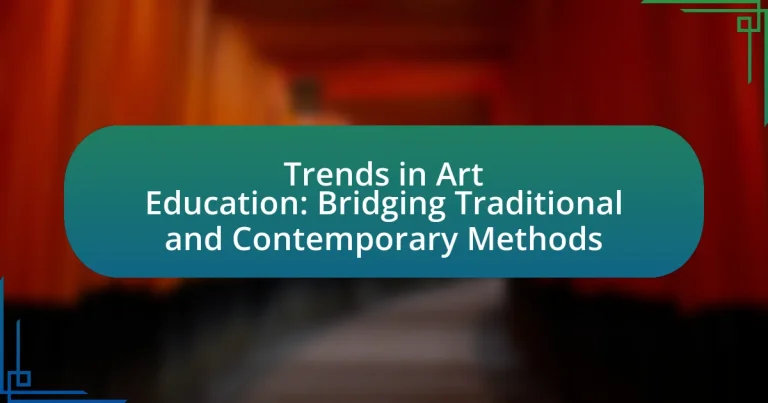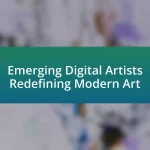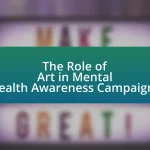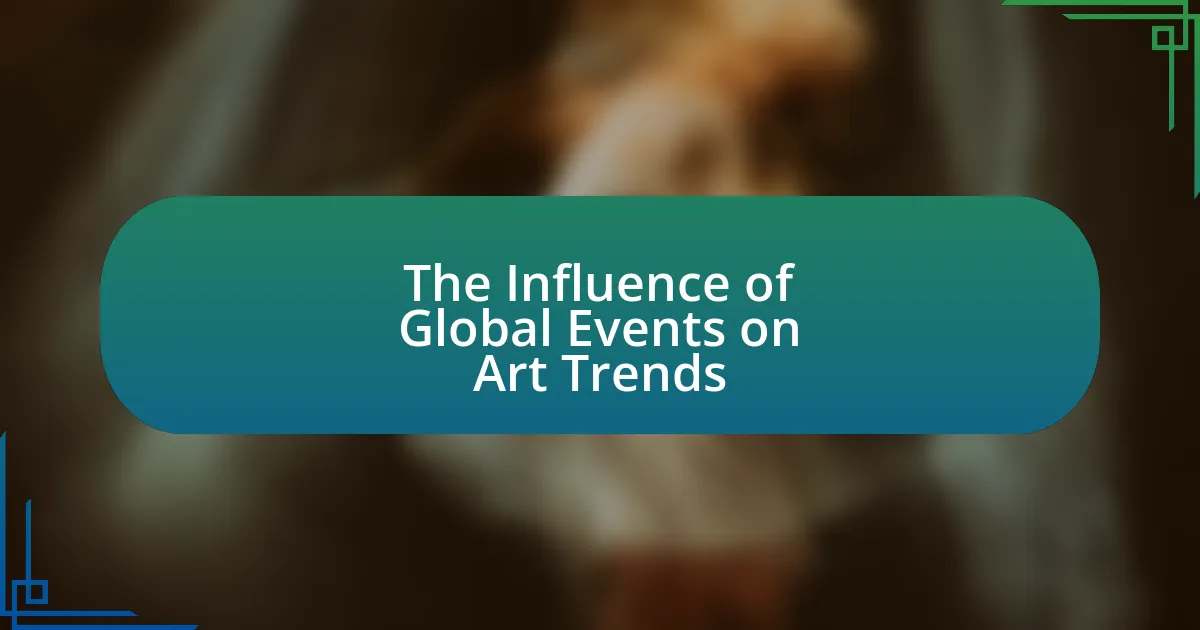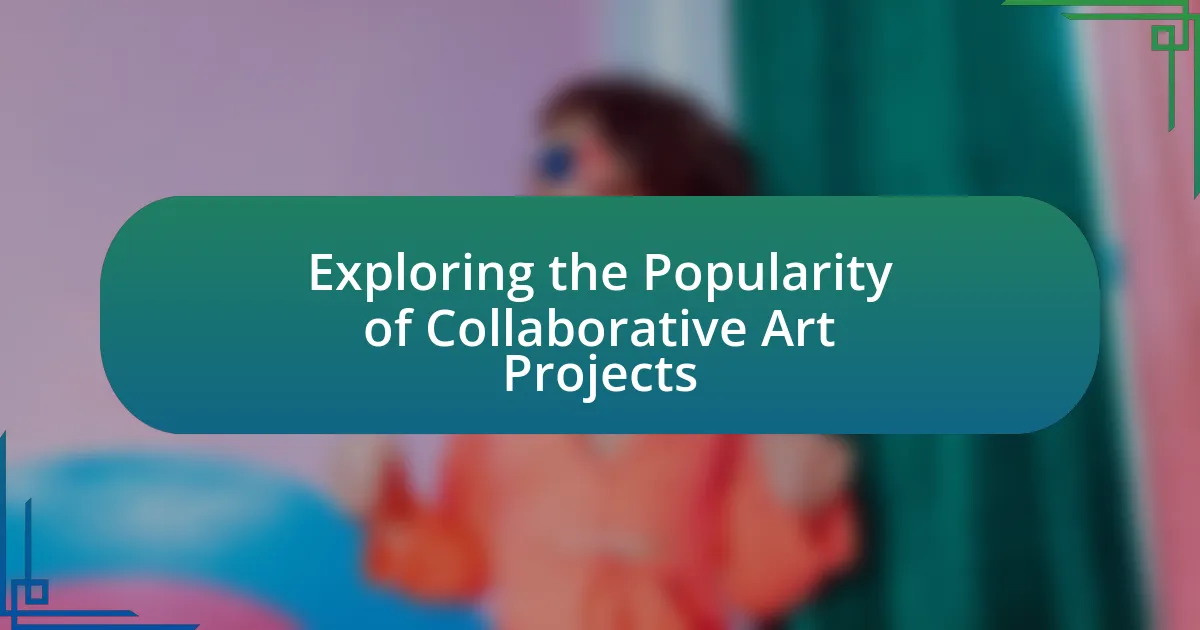The article focuses on current trends in art education, highlighting the integration of technology, interdisciplinary approaches, and inclusivity. It examines how traditional methods are being incorporated into modern curricula, emphasizing the relevance of techniques such as watercolor painting, oil painting, and printmaking. The discussion includes the role of technology in enhancing accessibility and creativity, as well as the challenges educators face in integrating these tools. Additionally, it explores the importance of bridging traditional and contemporary methods to foster student creativity and expression, while also addressing the varying approaches to art education across different educational institutions and cultures. Finally, the article outlines emerging pedagogical strategies and future directions for art education, emphasizing the need for educators to adapt to evolving trends.
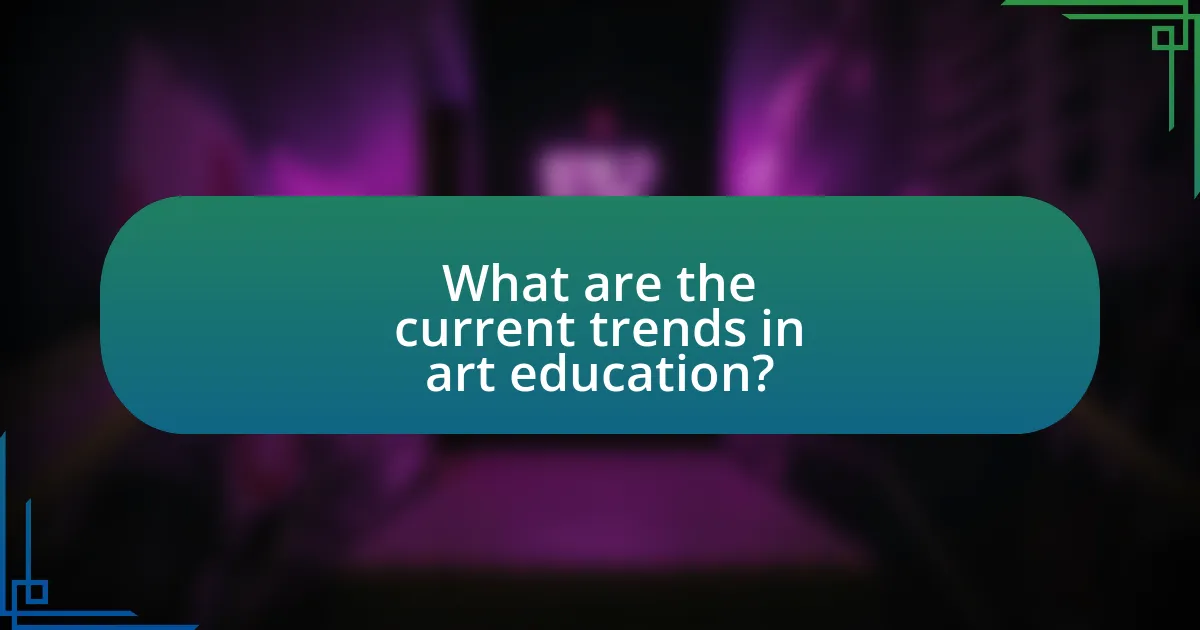
What are the current trends in art education?
Current trends in art education emphasize the integration of technology, interdisciplinary approaches, and inclusivity. Art education now frequently incorporates digital tools such as virtual reality and online platforms, allowing students to explore new mediums and reach broader audiences. Additionally, educators are increasingly adopting interdisciplinary methods, blending art with subjects like science and technology to foster creativity and critical thinking. Inclusivity is also a significant trend, with programs designed to engage diverse populations and promote equity in access to art education. These trends reflect a shift towards a more holistic and accessible approach to teaching art, aligning with contemporary societal needs and technological advancements.
How are traditional methods being integrated into modern art education?
Traditional methods are being integrated into modern art education through a combination of hands-on techniques, historical context, and foundational skills training. Art programs increasingly emphasize the importance of traditional practices, such as drawing from life and mastering classical painting techniques, alongside contemporary digital tools and concepts. For instance, many institutions now incorporate workshops that focus on traditional mediums like oil painting and printmaking, allowing students to develop a strong technical foundation. This approach is supported by research indicating that students who engage with traditional methods exhibit improved creativity and problem-solving skills, as evidenced by studies from the National Art Education Association.
What specific traditional techniques are still relevant today?
Specific traditional techniques that remain relevant today include watercolor painting, oil painting, and printmaking. Watercolor painting is valued for its transparency and fluidity, allowing artists to create delicate washes and intricate details. Oil painting, known for its rich colors and versatility, continues to be a preferred medium for many contemporary artists, enabling them to achieve depth and texture. Printmaking techniques, such as etching and lithography, are still widely taught and practiced, providing artists with unique ways to reproduce their work and explore different textures. These techniques are foundational in art education, bridging the gap between historical practices and modern artistic expression.
How do educators balance traditional and contemporary approaches?
Educators balance traditional and contemporary approaches by integrating foundational skills with modern techniques and technologies. This integration allows for a comprehensive learning experience that respects historical art practices while embracing current trends and tools. For instance, educators may teach classical drawing techniques alongside digital art software, enabling students to appreciate the roots of art while also developing relevant skills for today’s creative industries. Research indicates that this blended approach enhances student engagement and creativity, as it caters to diverse learning styles and prepares students for a multifaceted art world.
What role does technology play in contemporary art education?
Technology plays a crucial role in contemporary art education by enhancing accessibility, fostering creativity, and facilitating collaboration among students and educators. Digital tools such as graphic design software, virtual reality, and online platforms enable students to explore new mediums and techniques that were previously unavailable or difficult to access. For instance, the integration of digital art tools in curricula allows students to experiment with various styles and concepts, promoting innovative thinking. Additionally, online resources and communities provide opportunities for collaboration and feedback, which are essential for artistic growth. Research indicates that technology in education can improve engagement and learning outcomes, as seen in studies highlighting increased student motivation and participation when using digital tools in art classes.
How are digital tools transforming the learning experience?
Digital tools are transforming the learning experience by enhancing accessibility, interactivity, and personalization in education. For instance, platforms like Google Classroom and educational apps allow students to access resources anytime and anywhere, breaking geographical barriers. Research indicates that 70% of educators believe technology improves student engagement, as interactive tools such as virtual reality and gamified learning experiences foster active participation. Furthermore, adaptive learning technologies tailor educational content to individual learning paces and styles, which has been shown to improve retention rates by up to 30%. These advancements illustrate how digital tools are reshaping educational methodologies and outcomes.
What are the challenges of incorporating technology in art education?
Incorporating technology in art education presents several challenges, including access to resources, teacher training, and curriculum integration. Limited access to technology can hinder students’ ability to engage with digital tools, as evidenced by a report from the National Center for Education Statistics, which found that 14% of students lacked access to a computer at home. Additionally, many art educators may not have received adequate training in using technology effectively, leading to a gap in teaching methods. A study published in the Journal of Art Education highlighted that 60% of art teachers felt unprepared to integrate technology into their lessons. Finally, aligning technology with existing art curricula can be complex, as educators must balance traditional techniques with new digital practices, which can create resistance to change among both teachers and students.
Why is it important to bridge traditional and contemporary methods?
Bridging traditional and contemporary methods is important because it fosters a comprehensive understanding of art that integrates historical context with modern practices. This integration allows students to appreciate the evolution of artistic techniques and philosophies, enhancing their creative expression and critical thinking skills. Research indicates that art education that combines both approaches leads to improved student engagement and innovation, as evidenced by studies showing that students exposed to diverse methodologies demonstrate greater artistic versatility and problem-solving abilities.
What benefits arise from a blended approach to art education?
A blended approach to art education enhances creativity and engagement by integrating traditional techniques with contemporary digital tools. This combination allows students to explore diverse mediums and methods, fostering a more comprehensive understanding of art. Research indicates that students in blended learning environments demonstrate improved critical thinking skills and higher levels of motivation, as they can tailor their learning experiences to their interests and strengths. For instance, a study published in the Journal of Art Education found that students who engaged in both hands-on and digital art practices reported greater satisfaction and skill development compared to those who focused solely on one method.
How does this bridging impact student creativity and expression?
Bridging traditional and contemporary methods in art education enhances student creativity and expression by providing diverse tools and perspectives. This integration allows students to explore various artistic techniques and concepts, fostering innovation and personal voice in their work. Research indicates that exposure to multiple art forms encourages critical thinking and experimentation, which are essential for creative development. For instance, a study by the National Art Education Association found that students engaged in a curriculum combining traditional skills with modern practices demonstrated higher levels of creative output and self-expression.
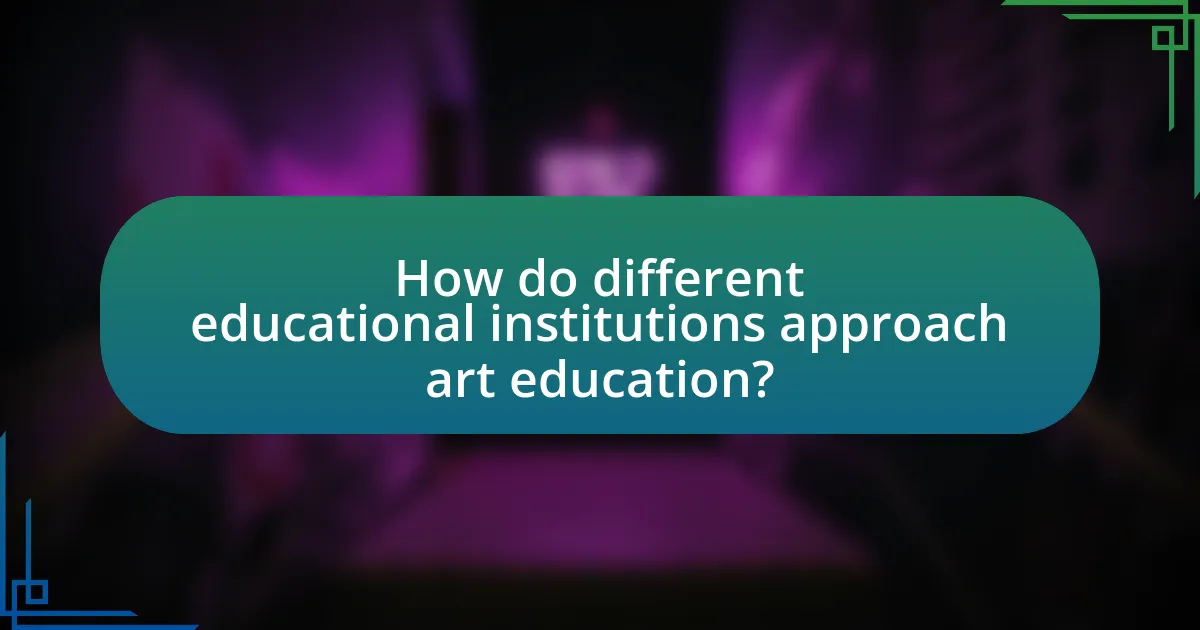
How do different educational institutions approach art education?
Different educational institutions approach art education through a variety of methodologies that reflect their educational philosophies and objectives. For instance, traditional institutions often emphasize foundational skills in drawing, painting, and sculpture, focusing on techniques and art history, while contemporary institutions may prioritize interdisciplinary practices, encouraging students to explore digital media, installation art, and social engagement. Research indicates that schools integrating project-based learning and community involvement see enhanced creativity and critical thinking among students, as evidenced by studies from the National Art Education Association, which highlight the benefits of experiential learning in art education.
What are the differences between public and private art education programs?
Public art education programs are funded and operated by government entities, while private art education programs are financed through tuition and private donations. Public programs typically offer lower tuition rates and are accessible to a broader demographic, often emphasizing community engagement and inclusivity. In contrast, private programs may provide specialized curricula, smaller class sizes, and more individualized attention, catering to specific artistic disciplines or advanced training. According to the National Endowment for the Arts, public art education initiatives often aim to enhance cultural participation and accessibility, whereas private institutions may focus on developing professional artists and providing networking opportunities within the art industry.
How do funding and resources affect art education quality?
Funding and resources significantly impact the quality of art education by determining the availability of materials, facilities, and qualified instructors. Schools with adequate funding can provide a diverse range of art supplies, access to technology, and well-maintained studios, which enhance the learning experience. For instance, a study by the National Endowment for the Arts found that schools with higher funding levels offer more comprehensive art programs, leading to improved student engagement and creativity. Conversely, underfunded programs often struggle to provide basic resources, resulting in limited curriculum options and diminished educational outcomes.
What unique opportunities do private institutions offer?
Private institutions offer unique opportunities such as personalized education, smaller class sizes, and specialized programs that cater to individual student interests. These features enable tailored learning experiences, fostering creativity and innovation in art education. For instance, private institutions often have the flexibility to design curricula that integrate both traditional techniques and contemporary practices, allowing students to explore diverse artistic expressions. Additionally, private institutions frequently provide access to exclusive resources, such as specialized workshops and mentorship from industry professionals, enhancing students’ practical skills and networking opportunities.
How do art education programs vary across cultures?
Art education programs vary significantly across cultures in their approaches, content, and methodologies. For instance, Western art education often emphasizes individual expression and critical thinking, focusing on contemporary techniques and concepts, while Eastern art education may prioritize traditional techniques and collective harmony, reflecting cultural values. In Japan, for example, art education incorporates practices like calligraphy and ink painting, which are deeply rooted in history and philosophy, contrasting with the more experimental and diverse practices found in Western curricula. This variation is supported by studies such as “Cultural Influences on Art Education” by Smith and Lee, which highlight how cultural context shapes educational priorities and artistic expression in different regions.
What traditional practices are preserved in different cultural contexts?
Traditional practices preserved in different cultural contexts include indigenous storytelling, traditional crafts, and ritualistic performances. For instance, Native American tribes maintain oral traditions that convey history and values through storytelling, which is integral to their cultural identity. Similarly, the Japanese practice of Ikebana, the art of flower arrangement, reflects aesthetic principles and spiritual beliefs rooted in centuries-old customs. Additionally, African communities often engage in dance and music rituals that celebrate heritage and community cohesion, showcasing the importance of these practices in cultural continuity. These examples illustrate how traditional practices serve as vital links to cultural heritage across various societies.
How do contemporary influences shape global art education?
Contemporary influences shape global art education by integrating diverse cultural perspectives and technological advancements into curricula. This integration fosters a more inclusive and relevant learning environment, reflecting the globalized nature of society. For instance, the rise of digital media has led to the incorporation of new tools and platforms in art education, allowing students to explore innovative forms of expression. Additionally, contemporary social movements, such as those advocating for equity and sustainability, have prompted art educators to address critical issues within their teaching, encouraging students to engage with and respond to current global challenges. These shifts are supported by research indicating that art education that embraces contemporary influences enhances creativity and critical thinking skills among students, preparing them for a dynamic and interconnected world.
What are the emerging pedagogical strategies in art education?
Emerging pedagogical strategies in art education include project-based learning, interdisciplinary approaches, and the integration of technology. Project-based learning encourages students to engage in hands-on, real-world projects that foster creativity and critical thinking. Interdisciplinary approaches combine art with subjects like science and history, enhancing students’ understanding and appreciation of both fields. The integration of technology, such as digital tools and online platforms, allows for innovative expression and collaboration among students. These strategies are supported by research indicating that active, collaborative, and technology-enhanced learning environments significantly improve student engagement and outcomes in art education.
How does project-based learning enhance art education?
Project-based learning enhances art education by fostering creativity and critical thinking through hands-on, real-world projects. This approach allows students to engage deeply with artistic concepts, as they apply their skills to create tangible outcomes, such as exhibitions or performances. Research indicates that project-based learning increases student motivation and retention of knowledge, as evidenced by a study published in the “Journal of Art Education,” which found that students involved in project-based art classes demonstrated higher levels of engagement and artistic skill development compared to traditional methods.
What role does collaboration play in modern art classrooms?
Collaboration plays a crucial role in modern art classrooms by fostering creativity and enhancing learning experiences. In collaborative settings, students engage in shared projects that encourage diverse perspectives, leading to innovative outcomes. Research indicates that collaborative learning can improve critical thinking and problem-solving skills, as students learn to communicate effectively and integrate various ideas. For instance, a study published in the Journal of Art Education found that group projects in art classes resulted in higher levels of student engagement and satisfaction, demonstrating the positive impact of collaboration on artistic development.
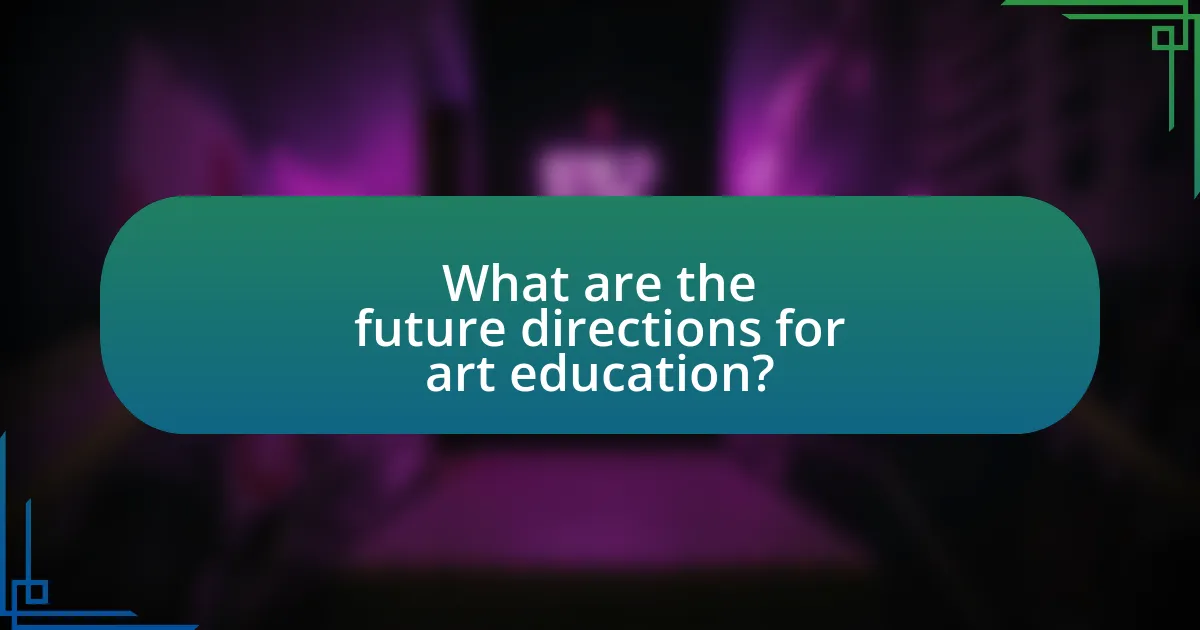
What are the future directions for art education?
Future directions for art education include integrating technology, promoting interdisciplinary approaches, and emphasizing social justice and community engagement. The incorporation of digital tools and platforms allows students to explore new mediums and reach wider audiences, as evidenced by the rise of online art classes and virtual exhibitions. Interdisciplinary approaches encourage collaboration between art and other subjects, fostering critical thinking and creativity, which aligns with educational trends emphasizing STEAM (Science, Technology, Engineering, Arts, and Mathematics). Additionally, a focus on social justice in art education aims to empower students to address societal issues through their work, reflecting a growing recognition of the role of art in activism and community building. These trends indicate a shift towards a more inclusive and relevant art education that prepares students for contemporary challenges.
How can art educators prepare for evolving trends?
Art educators can prepare for evolving trends by integrating technology into their curricula and staying informed about contemporary art practices. This approach allows educators to enhance student engagement and relevance in a rapidly changing artistic landscape. For instance, incorporating digital tools such as virtual reality and online platforms can facilitate innovative teaching methods and broaden access to diverse artistic expressions. Research indicates that 70% of art educators believe that technology integration significantly improves student learning outcomes (National Art Education Association, 2021). By continuously updating their skills and knowledge through professional development and collaboration with peers, art educators can effectively adapt to and embrace new trends in the field.
What skills will be essential for future art educators?
Future art educators will need strong digital literacy skills to effectively integrate technology into their teaching. As art education increasingly incorporates digital tools and platforms, educators must be proficient in software for digital art creation, online collaboration, and virtual teaching methods. Research indicates that 75% of art educators believe that digital skills are essential for preparing students for contemporary artistic practices (National Art Education Association, 2021). Additionally, future art educators should possess adaptability to navigate the evolving landscape of art education, which includes blending traditional techniques with contemporary practices. This adaptability is crucial as it allows educators to respond to diverse student needs and integrate new artistic trends into their curriculum.
How can educators stay updated with technological advancements?
Educators can stay updated with technological advancements by actively engaging in professional development opportunities, such as workshops, online courses, and conferences focused on educational technology. Research indicates that educators who participate in continuous learning are better equipped to integrate new technologies into their teaching practices. For instance, a study by the International Society for Technology in Education (ISTE) found that teachers who regularly attend technology-focused professional development are more likely to implement innovative tools effectively in their classrooms. Additionally, subscribing to educational technology journals and following relevant online communities can provide ongoing insights into emerging trends and tools in the field.
What are the best practices for integrating traditional and contemporary methods?
The best practices for integrating traditional and contemporary methods in art education include fostering a balanced curriculum that values both approaches, encouraging collaboration between educators, and utilizing technology to enhance traditional techniques. A balanced curriculum ensures that students appreciate the historical context and foundational skills of traditional methods while also exploring innovative contemporary practices. Collaboration among educators allows for the sharing of diverse perspectives and techniques, enriching the learning experience. Additionally, incorporating technology, such as digital tools and online platforms, can modernize traditional practices, making them more accessible and relevant to today’s learners. These practices are supported by research indicating that a hybrid approach enhances student engagement and creativity, as seen in studies like “The Impact of Blended Learning on Student Engagement” by Graham et al., which highlights the effectiveness of combining various teaching methodologies.
How can educators create a curriculum that reflects both approaches?
Educators can create a curriculum that reflects both traditional and contemporary approaches by integrating foundational art techniques with modern artistic practices and technologies. This can be achieved by incorporating lessons that emphasize classical skills, such as drawing and painting, alongside contemporary methods like digital art and mixed media. Research indicates that a balanced curriculum enhances student engagement and creativity, as evidenced by studies showing that students exposed to diverse artistic methodologies demonstrate improved critical thinking and problem-solving skills. By blending these approaches, educators can foster a comprehensive learning environment that prepares students for various artistic expressions and career paths.
What resources are available for teachers to enhance their methods?
Teachers can enhance their methods through various resources, including professional development workshops, online courses, and educational technology tools. Professional development workshops, such as those offered by the National Art Education Association, provide teachers with updated techniques and strategies tailored to contemporary art education. Online platforms like Coursera and EdX offer courses specifically focused on innovative teaching methods in art, allowing educators to learn at their own pace. Additionally, educational technology tools, such as digital art software and interactive whiteboards, facilitate creative expression and engagement in the classroom, aligning with modern pedagogical trends. These resources collectively support teachers in refining their instructional practices and adapting to evolving educational landscapes.
What practical tips can educators implement in their classrooms?
Educators can implement collaborative projects that integrate both traditional and contemporary art techniques to enhance student engagement and creativity. By encouraging students to work together on art pieces that combine classical methods, such as drawing or painting, with modern approaches like digital art or mixed media, educators foster a dynamic learning environment. Research indicates that collaborative learning can improve critical thinking and problem-solving skills, as highlighted in the study “The Impact of Collaborative Learning on Student Engagement” by Johnson and Johnson (2014). This approach not only bridges the gap between different art forms but also prepares students for diverse artistic expressions in the modern world.
